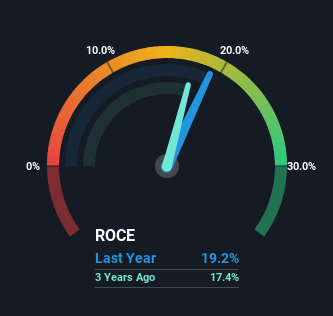- United States
- /
- Entertainment
- /
- NasdaqGS:WMG
Investors Will Want Warner Music Group's (NASDAQ:WMG) Growth In ROCE To Persist

Did you know there are some financial metrics that can provide clues of a potential multi-bagger? Ideally, a business will show two trends; firstly a growing return on capital employed (ROCE) and secondly, an increasing amount of capital employed. This shows us that it's a compounding machine, able to continually reinvest its earnings back into the business and generate higher returns. With that in mind, we've noticed some promising trends at Warner Music Group (NASDAQ:WMG) so let's look a bit deeper.
Understanding Return On Capital Employed (ROCE)
For those that aren't sure what ROCE is, it measures the amount of pre-tax profits a company can generate from the capital employed in its business. To calculate this metric for Warner Music Group, this is the formula:
Return on Capital Employed = Earnings Before Interest and Tax (EBIT) ÷ (Total Assets - Current Liabilities)
0.19 = US$1.0b ÷ (US$8.8b - US$3.6b) (Based on the trailing twelve months to June 2024).
So, Warner Music Group has an ROCE of 19%. On its own, that's a standard return, however it's much better than the 11% generated by the Entertainment industry.
See our latest analysis for Warner Music Group

In the above chart we have measured Warner Music Group's prior ROCE against its prior performance, but the future is arguably more important. If you'd like to see what analysts are forecasting going forward, you should check out our free analyst report for Warner Music Group .
What The Trend Of ROCE Can Tell Us
Investors would be pleased with what's happening at Warner Music Group. The data shows that returns on capital have increased substantially over the last five years to 19%. Basically the business is earning more per dollar of capital invested and in addition to that, 54% more capital is being employed now too. So we're very much inspired by what we're seeing at Warner Music Group thanks to its ability to profitably reinvest capital.
On a separate but related note, it's important to know that Warner Music Group has a current liabilities to total assets ratio of 40%, which we'd consider pretty high. This effectively means that suppliers (or short-term creditors) are funding a large portion of the business, so just be aware that this can introduce some elements of risk. Ideally we'd like to see this reduce as that would mean fewer obligations bearing risks.
The Bottom Line
All in all, it's terrific to see that Warner Music Group is reaping the rewards from prior investments and is growing its capital base. Astute investors may have an opportunity here because the stock has declined 29% in the last three years. That being the case, research into the company's current valuation metrics and future prospects seems fitting.
Warner Music Group does come with some risks though, we found 3 warning signs in our investment analysis, and 1 of those is a bit unpleasant...
If you want to search for solid companies with great earnings, check out this free list of companies with good balance sheets and impressive returns on equity.
Valuation is complex, but we're here to simplify it.
Discover if Warner Music Group might be undervalued or overvalued with our detailed analysis, featuring fair value estimates, potential risks, dividends, insider trades, and its financial condition.
Access Free AnalysisHave feedback on this article? Concerned about the content? Get in touch with us directly. Alternatively, email editorial-team (at) simplywallst.com.
This article by Simply Wall St is general in nature. We provide commentary based on historical data and analyst forecasts only using an unbiased methodology and our articles are not intended to be financial advice. It does not constitute a recommendation to buy or sell any stock, and does not take account of your objectives, or your financial situation. We aim to bring you long-term focused analysis driven by fundamental data. Note that our analysis may not factor in the latest price-sensitive company announcements or qualitative material. Simply Wall St has no position in any stocks mentioned.
About NasdaqGS:WMG
Warner Music Group
Operates as a music entertainment company in the United States, the United Kingdom, Germany, and internationally.
Reasonable growth potential and fair value.


